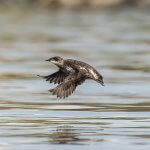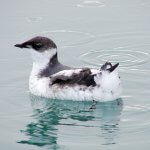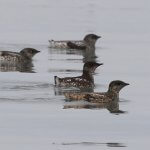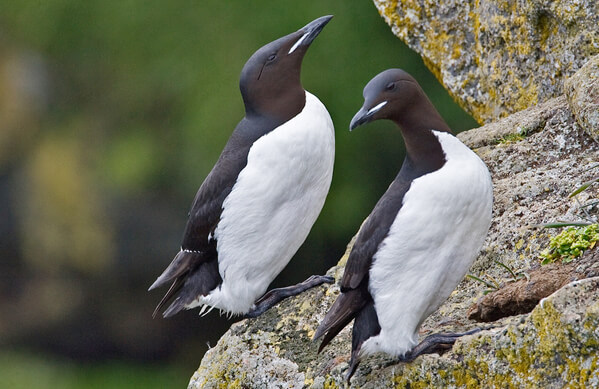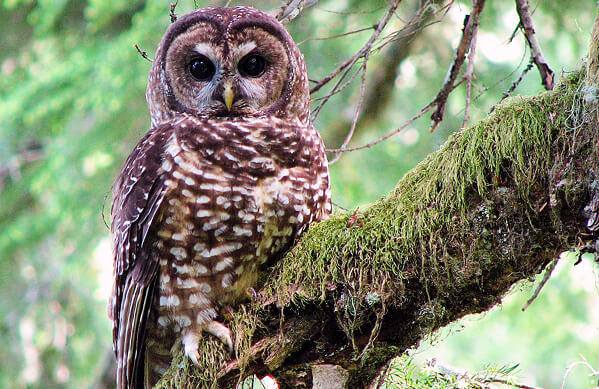About the Marbled Murrelet
Named for its dark breeding plumage, scalloped with white, this stub-tailed, quail-sized seabird frequents ocean waters off rocky Pacific coasts. This bird's nesting habits remained one of North America's greatest bird mysteries until 1974. That year, a tree surgeon working 147 feet up in a 200-foot-tall Douglas Fir found an active nest. This put this species in a league all its own; well, almost: Among the alcid family — which includes the Atlantic Puffin, Thick-billed Murre, and Rhinoceros Auklet — high-up tree nesting is unique to the Marbled Murrelet, and also its Asiatic close-cousin the Long-billed Murrelet (which was once considered the same species). In the northern part of its range where large trees don't occur, such as the Aleutian Islands and other parts of Alaska, these murrelets nest on the ground, usually among boulders or scree.
Marbled Murrelet populations appear to be in steady decline. The clearing of old-growth temperate rainforest, habitat this species shares with the Northern Spotted Owl, plays a major role in this drop.
Tidy Habits, Fewer Corvids
Recent studies document that many murrelet breeding attempts fail after predators locate eggs or young on their exposed nest branches. Ever vigilant and adaptable, Steller's and Canada Jays, American Crows, and Common Ravens seek eggs and vulnerable nestlings, but also garbage left by people visiting parks — and sloppy picnic- and campsites can boost these species' populations.
Luckily, there is evidence that cleaner campsites and picnic grounds deter these birds. California State Parks launched a "Crumb Clean" campaign in 2013 — offering camper education and better ways to dispose of waste, including wildlife-proof garbage cans, food lockers, and dishwashing stations. The program substantially reduced the number of Steller's Jays in areas where the program was implemented in California. ABC is now helping to expand this program to Oregon and Washington.
Songs and Sounds
Although the Marbled Murrelet doesn't sing, it sounds off in a variety of ways, both when flying over forest breeding habitat and while at sea. Its vocalizations include a variety of keer calls, whistles, and sometimes a drawn-out groan.
Keer calls:
Keer calls and groans:
Breeding and Feeding
Leaving an Impression
The Marbled Murrelet flies as far as 50 miles inland in search of suitable nesting habitat. It often nests high up in a tall tree, on a soft carpet of lichen or moss adorning a large, horizontal branch. The adults' weight creates a depression where the female lays the pair's single egg. Both parents take turns incubating the egg, alternating day-long shifts swapped under cover of darkness. The egg hatches after about 30 days.
Adults, whose mottled brown-and-white breeding plumage provides camouflage in the dappled forest canopy, shuttle between ocean and nest to feed their nestling, which remains in the nest longer than most other alcids — from four to almost six weeks. Much of this time, but for occasional meal delivery, the chick is left unattended. Nestlings molt into black-and-white juvenile plumage before leaving the nest and flying directly to the ocean. (Adult birds molt into similar plumage after breeding.)
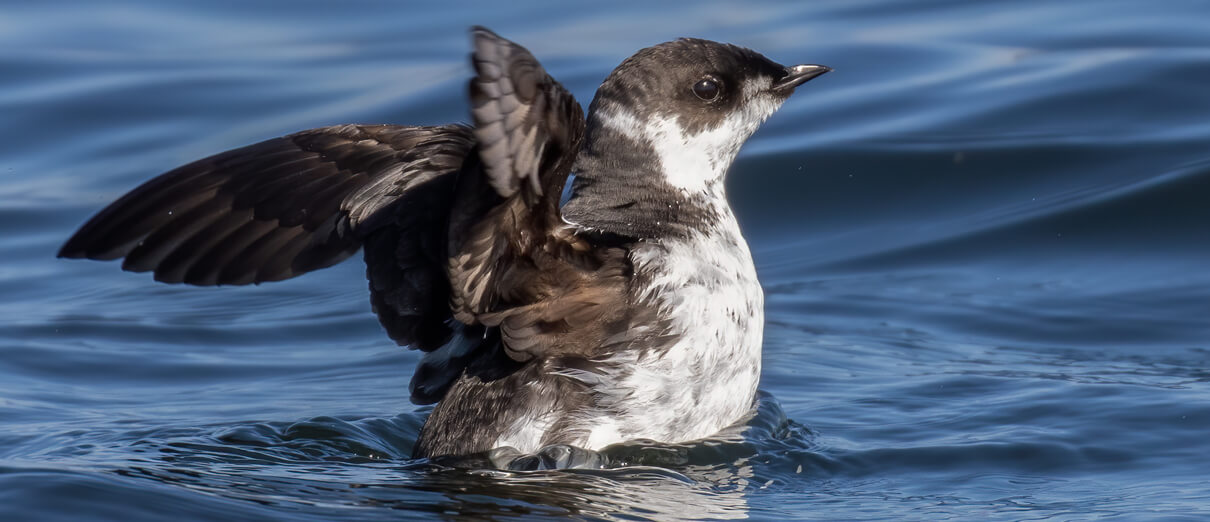
Like other alcids, the Marbled Murrelet has short wings, which it uses to swim up to 200 feet deep in search of small fish and invertebrates. This bird's diet varies depending upon local prey availability and season. Important food sources include sand lance, anchovies, herring, sardines, seaperch, krill, and squid.
Murrelets must continuously flap their wings very quickly to fly, and they look like large bumblebees as they skim over the surface of the water. At sea, they are often found feeding in pairs near the shore, often within a mile of land.
Region and Range
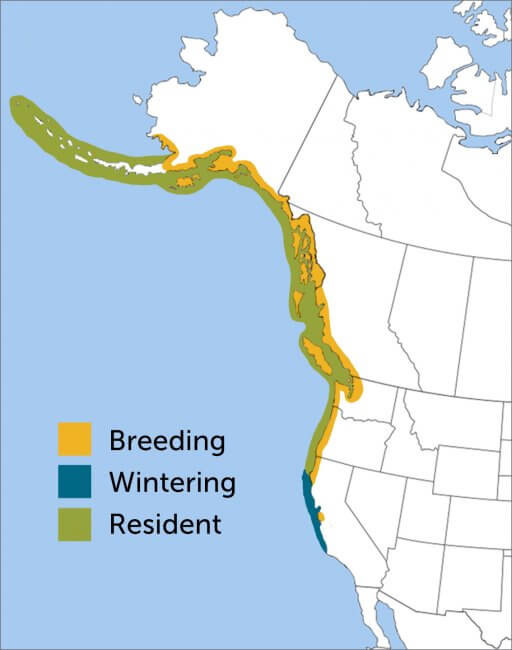
The Marbled Murrelet breeds from Alaska's far-western islands along the Pacific coastline to central California (where it is now a scarce breeder). Across much of the species' range, the birds winter in sheltered waters not far from nesting areas. In parts of Alaska and British Columbia, however, many birds leave to winter elsewhere. Marbled Murrelets rarely stray to southern California and northernmost Mexico in winter (not shown on map).
Conservation
The International Union for Conservation of Nature ranks the Marbled Murrelet as Endangered. The species' lower 48 population was federally listed as Threatened under the Endangered Species Act in 1992; it is also listed as Threatened under the Canadian Species at Risk Act.
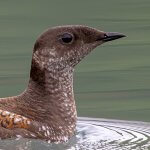
Help support ABC's conservation mission!
Commercial logging of old-growth forests poses the greatest danger to this species' breeding habitat. Other threats contributing to the Marbled Murrelet's decline include habitat changes caused by climate change. At sea, the birds are threatened by oil spills and unsustainable practices in the fisheries industry, such as the use of gillnets, which cause incidental take of murrelets and other seabirds. On land, as mentioned above, jays, crows, and ravens prey on murrelet eggs and nestlings, particularly when fragmented forest habitat allows them easier access to nests.
ABC is advocating for strong conservation action, both in state initiatives and the federal Northwest Forest Plan, a "landscape approach to federal land management" on more than 24 million acres of public land that promotes sustainability and conservation actions across the southern portion of the Marbled Murrelet's range. In July 2023, the current administration appointed a new panel to update this plan over the next few years.
As mentioned above, the Crumb Clean program is promoting clean camping/picnicking in the three lower-48 states with Marbled Murrelet breeding populations: California, Oregon, and Washington. ABC is leading efforts to bring this successful program to the latter two states.
Get Involved
Policies enacted by the U.S. Congress and federal agencies have a huge impact on seabirds. You can help shape these rules for the better by telling lawmakers to prioritize birds and bird-friendly measures. To get started, visit ABC's Action Center.
Plastics pose a deadly threat to seabirds around the world. You can help seabirds by reducing your daily use of plastics. To learn more and get started, visit our Plastics page.
American Bird Conservancy and partners are creating predator-free nest sites for vulnerable seabird species, reducing fishery impacts, and much more. This is a monumental undertaking, requiring the support of many, and you can help by making a gift today.






































